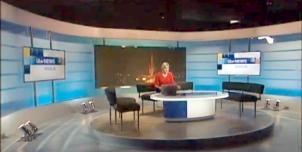Full Freeview on the Tacolneston (Norfolk, England) transmitter
| Google Streetview | Google map | Bing map | Google Earth | 52.518,1.139 or 52°31'6"N 1°8'22"E | NR16 1DW |
The symbol shows the location of the Tacolneston (Norfolk, England) transmitter which serves 330,000 homes. The bright green areas shown where the signal from this transmitter is strong, dark green areas are poorer signals. Those parts shown in yellow may have interference on the same frequency from other masts.
This transmitter has no current reported problems
The BBC and Digital UK report there are no faults or engineering work on the Tacolneston (Norfolk, England) transmitter._______
Digital television services are broadcast on a multiplexes (or Mux) where many stations occupy a single broadcast frequency, as shown below.
64QAM 8K 3/4 27.1Mb/s DVB-T MPEG2
DTG-12 QSPK 8K 3/4 8.0Mb/s DVB-T MPEG2
H/V: aerial position (horizontal or vertical)
Which Freeview channels does the Tacolneston transmitter broadcast?
If you have any kind of Freeview fault, follow this Freeview reset procedure first.Digital television services are broadcast on a multiplexes (or Mux) where many stations occupy a single broadcast frequency, as shown below.
64QAM 8K 3/4 27.1Mb/s DVB-T MPEG2
DTG-12 QSPK 8K 3/4 8.0Mb/s DVB-T MPEG2
H/V: aerial position (horizontal or vertical)
Which BBC and ITV regional news can I watch from the Tacolneston transmitter?

BBC Look East (East) 0.8m homes 3.2%
from Norwich NR2 1BH, 16km northeast (37°)
to BBC East region - 27 masts.
70% of BBC East (East) and BBC East (West) is shared output

ITV Anglia News 0.8m homes 3.2%
from NORWICH NR1 3JG, 16km northeast (38°)
to ITV Anglia (East) region - 26 masts.
All of lunch, weekend and 80% evening news is shared with Anglia (West)
Are there any self-help relays?
| Gt Yarmouth | Transposer | 1 km S town centre | 30 homes |
| Lowestoft (2) | Transposer | Rotterdam Rd | 125 homes |
How will the Tacolneston (Norfolk, England) transmission frequencies change over time?
| 1950s-80s | 1984-97 | 1997-98 | 1998-2011 | 2011-13 | 2013-18 | 2013-17 | 17 Jul 2018 | ||
| VHF | C/D E | C/D E | C/D E | E | E T | W T | W T | ||
| C3 | BBCtvwaves | ||||||||
| C31 | com7 | com7 | |||||||
| C32 | _local | ||||||||
| C37 | com8 | com8 | |||||||
| C39 | +ArqB | +ArqB | ArqB | ||||||
| C40 | BBCA | ||||||||
| C42 | SDN | SDN | SDN | SDN | |||||
| C43 | D3+4 | ||||||||
| C45 | ArqA | ArqA | ArqA | ArqA | |||||
| C46 | BBCB | ||||||||
| C50tv_off | BBCB | BBCB | |||||||
| C52tv_off | C5waves | C5waves | |||||||
| C55tv_off | BBC2waves | BBC2waves | BBC2waves | -BBCA | -BBCA | -BBCA | com7tv_off | ||
| C56tv_off | COM8tv_off | ||||||||
| C57tv_off | LNR | LNR | |||||||
| C59tv_off | ITVwaves | ITVwaves | ITVwaves | -D3+4 | -D3+4 | -D3+4 | |||
| C62 | BBC1waves | BBC1waves | BBC1waves | BBCB | |||||
| C65 | C4waves | C4waves | C4waves |
tv_off Being removed from Freeview (for 5G use) after November 2020 / June 2022 - more
Table shows multiplexes names see this article;
green background for transmission frequencies
Notes: + and - denote 166kHz offset; aerial group are shown as A B C/D E K W T
waves denotes analogue; digital switchover was 9 Nov 11 and 23 Nov 11.
How do the old analogue and currrent digital signal levels compare?
| Analogue 1-4 | 250kW | |
| SDN, ARQA, ARQB, BBCA, D3+4, BBCB | (-4dB) 100kW | |
| com7 | (-9.6dB) 27.4kW | |
| com8 | (-10.2dB) 24kW | |
| Mux 1*, Mux 2*, LNR | (-14dB) 10kW | |
| Mux A*, Mux B*, Mux C*, Mux D* | (-17dB) 5kW | |
| Analogue 5 | (-18dB) 4kW |
Local transmitter maps
Tacolneston Freeview Tacolneston DAB Tacolneston TV region BBC East Anglia (East micro region)Which companies have run the Channel 3 services in the Tacolneston transmitter area
|
|
Wednesday, 10 July 2013
K
Ken Robertson7:56 AM
No BBC1 or BBC2 signal from Tacelston. OK first thing this morning but then broke up during outside broadcast and has not returned. Date 10 July 2013.
| link to this comment |
Sunday, 21 July 2013
M
Margold8:46 PM
I have had so many problems lately just receiving a simple TV signal in my house. It drops out so often. What is so difficult about getting a Signal from a transmitter to a house.......or is it just us in Norfolk that suffer this.
| link to this comment |
Sunday, 28 July 2013
M
Mary Macer3:09 PM
I'm fed up with my Freeview reception via my VHS/DVD recorder-player going pear-shaped every now and again. This results in a loss of my Guide facility and blue-screen on my television screen. The regular TV reception is OK. WHEN IS TACOLNESTON GOING TO STOP MESSING ABOUT WITH THE SIGNAL WITH IT'S ENGINEERING WORKS etc.? It has happened twice quite recently. I am writing this in frustration and am not really expecting a reply, but it seems to happen just when I want to try and record a programme.
| link to this comment |
M
MikeB5:33 PM
Mary Macer: It would be helpful to know your postcode, since it woulhd be useful to know what sort of signal/terrain you have at your location.
Although Tacolneston has engineering working on this week (and Norfolk is certainly a Freeview problem area for lots of people), you should not have too much of a problem, unless your signal is already pretty marginal.
However, since you have said you have good reception on the other tuner/TV, and its a Panasonic your having a problem with, check the signal strength/quality of the signal on the PVR.
Panasonics have very sensetive tuners, and you could have too much signal, not too little. If you have a booster/amp, try bypassing it and see if things improve. You signal strength should be 75%, not 100%.
| link to this comment |
Monday, 29 July 2013
C
Colin W12:40 PM
Ipswich
I live in Tuddenham near Ipswich and use Tacholneston. My location is useless to receive Freeview from Sudbury and it is fringe for Tachnolneston. Ch55 (BBC) is badly affected during spells of hot weather but ITV, CH4 and HD are ok. The transmitted power is the same for all the Muxs. Can anyone explain why one transmitted frequency is affected more than the others?
| link to this comment |
Colin's: mapC's Freeview map terrainC's terrain plot wavesC's frequency data C's Freeview Detailed Coverage
Colin W: Because the others are "affected" less.
Because different frequencies are affected in different ways. This being particularly so in cases such as yours where there is no line-of-sight to the transmitter and therefore that you are relying of defraction (signal bending) around objects such as the higher ground over which the signal 'travels'. As things heat up, for example, the angle of defraction may change and therefore what was a good spot (which is presumably why your aerial was sited as such changes.
| link to this comment |
Sunday, 18 August 2013
A
Andy Hogg8:07 PM
very weak freeview signal from 10th August ongoing. High gain Loft Aerial used with booster.
postcode NR16, no line of sight to Tacolneston transmitter due to river Tas valley.
Has the move of BBCB in the frequency band reduced the effective signal of my aerial?
| link to this comment |
Sunday, 25 August 2013
B
B.BARTLETT 11:43 AM
Thetford
Hi i am in the tacalston signal but can not get a good signai ,about 50yds away is a big hrsechestnit tree when in leaf no signal .Any sugestion please
IP26 5LY
| link to this comment |
B.BARTLETT's: mapB's Freeview map terrainB's terrain plot wavesB's frequency data B's Freeview Detailed Coverage
M
mazbar11:49 AM
B.BARTLETT : a couple of suggestions can the aerial be mover away from the tree and still in line is sight of the transmitter, if it carn't sometimes if there is strong signal but it get affected when the wind blows the leafs you can lower the aerial into the trunk of the tree, the trunk doesn't move so if you can get signal lower down it should stay stable if not you may have to try freesat hope this helps
| link to this comment |
Thursday, 29 August 2013
J
jody8:10 AM
Hey, for a couple of weeks ive had next to no signal and lost all bbc channels and most of channel 4 too. Brought a new freeview hd box and now I have the same problem except it seems all of my channels are lacking signal. Is this to do with my aerial? And how am I able to tell what type of aerial I have? Any help would be much appreciated, especially help that requires spending little money!
| link to this comment |
Select more comments
Your comment please!





